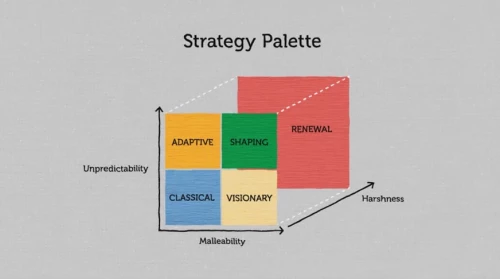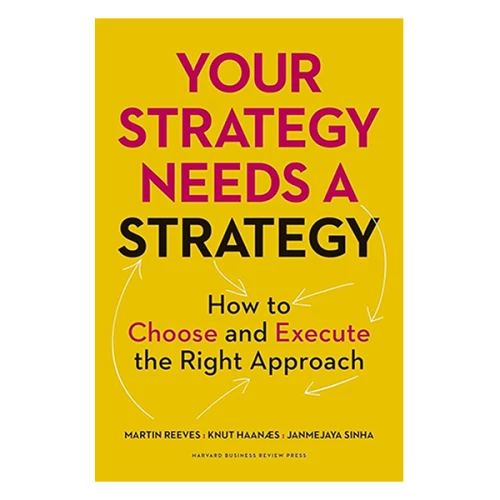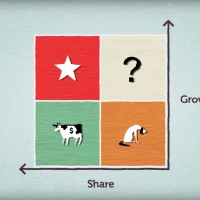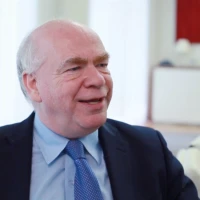The Strategy Palette
The strategy palette proposes five distinct approaches to strategy, helping leaders to match their approach to their business environment and execute effectively, combine different approaches, and animate the strategic collage of approaches.
Learn More About Strategy Approaches
The strategy palette proposes five distinct approaches to strategy: classical, adaptive, visionary, shaping, and renewal.
Classical strategy is based on achieving sustainable competitive advantage by positioning a firm optimally in an attractive market.
Unlike the classical approach of sustainable competitive advantage, an adaptive approach to strategy rests on the idea of serial temporary advantage.
Rare but incredibly effective, a visionary approach empowers a firm to create or recreate an industry with some degree of predictability by seeing an opportunity and pursuing it single-mindedly.
Shaping firms mold or reshape an industry by influencing the development of a market in its favor through coordination with other players.
A renewal approach to strategy refreshes the vitality and competitiveness of a firm when it is operating in a harsh environment.
Learn More About Combining Strategies
Ambidexterity is the ability to apply multiple approaches to strategy either concurrently or successively, since many firms operate in more than one strategic environment at once.
Successful firms meet the challenge of selecting, combining, and effectively implementing the appropriate combination of strategic approaches—what we refer to as the strategy collage—and adjusting it dynamically as circumstances change. We identified eight key leadership roles in today's complex and dynamic environment.
Book
Your Strategy Needs a Strategy
This book from BCG’s Strategy Lab cuts through the clutter of strategy frameworks and provides clarity on which approach to strategy and execution—or which combination of approaches—is the best bet in each environment. The first chapter of Your Strategy Needs a Strategy explains why strategy has never been more important and why picking the right approach to strategy for a given business environment is critical.
Meet the Authors

Alumnus
Knut Haanæs
Alumnus
Geneva
Other Resources

Your Strategy Needs a Strategy App Workshop
-
 Your Strategy Needs a Strategy App Workshop
Your Strategy Needs a Strategy App Workshop Your Strategy Needs a Strategy App Workshop
Your Strategy Needs a Strategy App Workshop -
 Your Strategy Needs a Strategy Online Learning Course
Your Strategy Needs a Strategy Online Learning Course Your Strategy Needs a Strategy Online Learning Course
Your Strategy Needs a Strategy Online Learning Course
Learn More
In this TED talk, Reeves advocates transitioning from relying on a single "classical" approach to strategy and moving toward a more tailored approach to strategy and execution, selecting from five distinct patterns of success.
Understanding the principles that confer robustness in complex systems—such as tropical forests, stock markets, and even companies—can mean the difference between survival and extinction.
In the 1970s and 80s, nearly half the Fortune 500 are reported to have used BCG’s growth share matrix to design and operate their strategies. Today, technology is transforming every facet of the business experience. The question arises: Is the growth share matrix still relevant?
The professor of war studies discusses the relevance of strategy in today’s increasingly dynamic world and where the next big advances in strategy will come from.
Biology and Strategy: Natural Strategy
Flora and fauna are, in some respects, the first home of strategy. Nature displays an enormous range of strategies that have been selected over time for fitness under different circumstances, long before humans walked the earth, let alone articulated the concept of strategy or competitive advantage. Biology illustrates the need for different strategic approaches under varying circumstances and provides a rich source of inspiration for understanding the range of possible approaches.
Consider the variety of strategies employed by plant species in a forest: some exploit a narrow or temporary niche, others enter into symbiotic or parasitic relationships with other species, and yet others dominate once the ecosystem of the forest has reached a steady state.
Nature’s repository of examples and analogies can help broaden our understanding of strategizing in diverse environments beyond the classical planning-oriented perspective. We drew inspiration for the strategy palette by considering this variety of natural strategies, and we explore biological analogies for each cell in the palette.
Consider the variety of strategies employed by plant species in a forest: some exploit a narrow or temporary niche, others enter into symbiotic or parasitic relationships with other species, and yet others dominate once the ecosystem of the forest has reached a steady state.
Nature’s repository of examples and analogies can help broaden our understanding of strategizing in diverse environments beyond the classical planning-oriented perspective. We drew inspiration for the strategy palette by considering this variety of natural strategies, and we explore biological analogies for each cell in the palette.
Acknowledgments and References
The Strategy Palette builds on the contributions of several authors in the fields of contingent strategy (choosing strategy according to a particular set of circumstances) and meta-strategy (strategies for choosing a strategy). The following references are especially recommended for those who want to deepen their understanding, and trace the evolution, of those ideas.
- Henderson, Bruce. “ The Product Portfolio,” BCG Perspectives, 1970.
- Lochridge, Richard. “Strategy in the 1980s,” BCG Perspectives, 1981.
- Nadler, David A., and Michael L. Tushman. “Beyond the Charismatic Leader: Leadership and Organizational Change,” California Management Review, Winter 1990.
- Nadler, David A., and Michael L. Tushman. “Types of Organizational Change: From Incremental Improvement to Discontinuous Transformation,” in Discontinuous Change: Leading Organizational Transformation, edited by David A. Nadler et al., 15–34. Jossey-Bass, 1995.
- Abell, Derek F. “ Competing Today While Preparing for Tomorrow,” MIT Sloan Management Review 40, no. 3 (1999): 73.
- Wiltbank, Robert, Nicholas Dew, Stuart Read, and Saras D. Sarasvathy. “What to Do Next? The Case for Non‐Predictive Strategy,” Strategic Management Journal 27, no. 10 (2006): 981-998.
Classical Strategy
To deploy a classical strategic approach, organizations must be in a stable market with established bases of competition.















